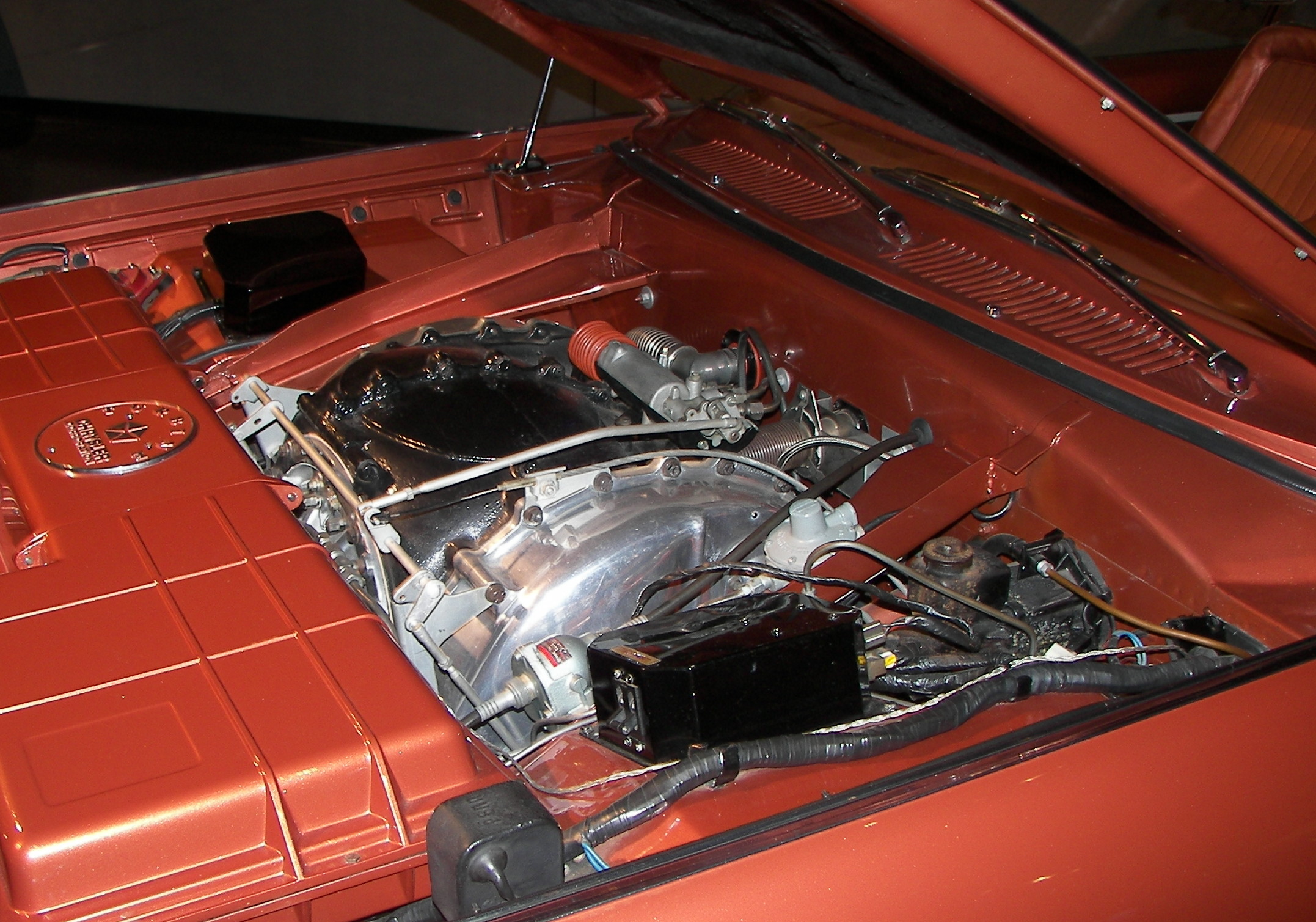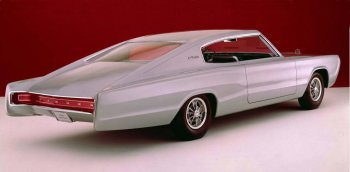|
Chrysler Turbine Engines
The Chrysler turbine engine is a series of gas turbine#In surface vehicles, gas turbine engines developed by Chrysler intended to be used in road vehicles. In 1954, Chrysler Corporation disclosed the development and successful road testing of a production model Plymouth sport coupe which was powered by a turbine engine. Development Tests of the Chrysler Turbine were first run in 1954 and proved successful enough to convince project lead George Huebner of the engine's viability for further development. With the aim of keeping price competitive with its contemporaries, the team sought to address concerns with the engine of throttle response, noise, and to see if it was even possible to power a car using a jet engine. Likewise, new materials were developed to be resistant to the high temperatures of the engine's combustion chamber while remaining economical to manufacture at the scale of a mass-produced automobile. A number of benefits were also identified; the turbine engine bein ... [...More Info...] [...Related Items...] OR: [Wikipedia] [Google] [Baidu] |
Vegetable Oil Fuel
Vegetable oil can be used as an alternative fuel in diesel engines and in heating oil burners. When vegetable oil is used directly as a fuel, in either modified or unmodified equipment, it is referred to as straight vegetable oil (SVO) or pure plant oil (PPO). Conventional diesel engines can be modified to help ensure that the viscosity of the vegetable oil is low enough to allow proper atomization of the fuel. This prevents incomplete combustion, which would damage the engine by causing a build-up of carbon. Straight vegetable oil can also be blended with conventional diesel or processed into biodiesel, HVO or bioliquids for use under a wider range of conditions. History Rudolf Diesel was the father of the engine which bears his name. His first attempts were to design an engine to run on coal dust, but he later designed his engine to run on vegetable oil. The idea, he hoped, would make his engines more attractive to farmers having a source of fuel readily available. In a 1912 ... [...More Info...] [...Related Items...] OR: [Wikipedia] [Google] [Baidu] |
Dodge Charger (B-body)
The Dodge Charger (1966), also known as Dodge Charger (B-body), is a mid-size automobile that was produced by Dodge from 1966 through 1978 model years, and was based on the Chrysler B platform. Origin During the early 1960s, automakers were exploring new ideas in the personal luxury and specialty car segments. Chrysler, slow to enter the specialty car market, selected their Dodge Division to enter the marketplace with a mid-size Chrysler B platform, B-bodied sporty car to fit between the "pony car" Ford Mustang and "personal luxury car, personal luxury" Ford Thunderbird. The intention was to create a fastback look while sharing as much existing company hardware as possible. utilizing lessons learned from the luxury coupe Chrysler 300 letter series, Chrysler 300. The Dodge Coronet, Coronet-based Charger that resulted was introduced in mid-season of the 1966 model year in response to the Rambler Marlin, Ford Mustang, and Plymouth Barracuda. The styling was generally a departure ... [...More Info...] [...Related Items...] OR: [Wikipedia] [Google] [Baidu] |
Thermal Wheel
A thermal wheel, also known as a rotary heat exchanger, or rotary air-to-air enthalpy wheel, energy recovery wheel, or heat recovery wheel, is a type of energy recovery heat exchanger positioned within the supply and exhaust air streams of air-handling units or rooftop units or in the exhaust gases of an industrial process, in order to recover the heat energy. Other variants include enthalpy wheels and desiccant wheels. A cooling-specific thermal wheel is sometimes referred to as a Kyoto wheel. Rotary thermal wheels are a mechanical means of heat recovery. A rotating porous metallic wheel transfers thermal energy from one air stream to another by passing through each fluid alternately. The system operates by working as a thermal storage mass whereby the heat from the air is temporarily stored within the wheel matrix until it is transferred to the cooler air stream. Two types of rotary thermal wheels exist: heat wheels and enthalpy (desiccant) wheels. Though there is a geometric ... [...More Info...] [...Related Items...] OR: [Wikipedia] [Google] [Baidu] |
Automatic Transmission
An automatic transmission (AT) or automatic gearbox is a multi-speed transmission (mechanics), transmission used in motor vehicles that does not require any input from the driver to change forward gears under normal driving conditions. The 1904 Sturtevant "horseless carriage gearbox" is often considered to be the first true automatic transmission. The first mass-produced automatic transmission is the General Motors ''Hydramatic'' two-speed hydraulic automatic, which was introduced in 1939. Automatic transmissions are especially prevalent in vehicular drivetrains, particularly those subject to intense mechanical acceleration and frequent idle/transient operating conditions; commonly commercial/passenger/utility vehicles, such as buses and waste collection vehicles. Prevalence Vehicles with internal combustion engines, unlike electric vehicles, require the engine to operate in a narrow range of rates of rotation, requiring a gearbox, operated manually or automatically, to drive t ... [...More Info...] [...Related Items...] OR: [Wikipedia] [Google] [Baidu] |
Torque Converter
A torque converter is a device, usually implemented as a type of fluid coupling, that transfers rotating power from a prime mover, like an internal combustion engine, to a rotating driven load. In a vehicle with an automatic transmission, the torque converter connects the prime mover to the automatic gear train, which then drives the load. It is thus usually located between the engine's flexplate and the transmission. The equivalent device in a manual transmission is the mechanical clutch. A torque converter serves to increase transmitted torque when the output rotational speed is low. In the fluid coupling embodiment, it uses a fluid, driven by the vanes of an input impeller, and directed through the vanes of a fixed stator, to drive an output turbine in such a manner that torque on the output is increased when the output shaft is rotating more slowly than the input shaft, thus providing the equivalent of an adaptive reduction gear. This is a feature beyond what a simple fl ... [...More Info...] [...Related Items...] OR: [Wikipedia] [Google] [Baidu] |
Nitrogen Oxide
Nitrogen oxide may refer to a binary compound of oxygen and nitrogen, or a mixture of such compounds: Charge-neutral *Nitric oxide (NO), nitrogen(II) oxide, or nitrogen monoxide * Nitrogen dioxide (), nitrogen(IV) oxide * Nitrogen trioxide (), or nitrate radical *Nitrous oxide (), nitrogen(0,II) oxide * Dinitrogen dioxide (), nitrogen(II) oxide dimer * Dinitrogen trioxide (), nitrogen(II,IV) oxide * Dinitrogen tetroxide (), nitrogen(IV) oxide dimer *Dinitrogen pentoxide (), nitrogen(V) oxide, or nitronium nitrate * Nitrosyl azide (), nitrogen(−I,0,I,II) oxide * Nitryl azide () * Oxatetrazole () * Trinitramide ( or ), nitrogen(0,IV) oxide Anions Cations * Nitrosonium ( or ) * Nitronium ( or ) Atmospheric sciences In atmospheric chemistry: * (or NO''x'') refers to the sum of NO and . * (or NO''y'') refers to the sum of and all oxidized atmospheric odd-nitrogen species (''e.g.'' the sum of , , , etc.) * (or NO''z'') = − * Mixed Oxides of Nitrogen ("MON"): solu ... [...More Info...] [...Related Items...] OR: [Wikipedia] [Google] [Baidu] |
Hydrocarbon
In organic chemistry, a hydrocarbon is an organic compound consisting entirely of hydrogen and carbon. Hydrocarbons are examples of group 14 hydrides. Hydrocarbons are generally colourless and Hydrophobe, hydrophobic; their odor is usually faint, and may be similar to that of gasoline or Naphtha, lighter fluid. They occur in a diverse range of molecular structures and phases: they can be gases (such as methane and propane), liquids (such as hexane and benzene), low melting solids (such as paraffin wax and naphthalene) or polymers (such as polyethylene and polystyrene). In the fossil fuel industries, ''hydrocarbon'' refers to naturally occurring petroleum, natural gas and coal, or their hydrocarbon derivatives and purified forms. Combustion of hydrocarbons is the main source of the world's energy. Petroleum is the dominant raw-material source for organic commodity chemicals such as solvents and polymers. Most anthropogenic (human-generated) emissions of greenhouse gases are eithe ... [...More Info...] [...Related Items...] OR: [Wikipedia] [Google] [Baidu] |
Carbon
Carbon () is a chemical element; it has chemical symbol, symbol C and atomic number 6. It is nonmetallic and tetravalence, tetravalent—meaning that its atoms are able to form up to four covalent bonds due to its valence shell exhibiting 4 electrons. It belongs to group 14 of the periodic table. Carbon makes up about 0.025 percent of Earth's crust. Three Isotopes of carbon, isotopes occur naturally, carbon-12, C and carbon-13, C being stable, while carbon-14, C is a radionuclide, decaying with a half-life of 5,700 years. Carbon is one of the timeline of chemical element discoveries#Pre-modern and early modern discoveries, few elements known since antiquity. Carbon is the 15th abundance of elements in Earth's crust, most abundant element in the Earth's crust, and the abundance of the chemical elements, fourth most abundant element in the universe by mass after hydrogen, helium, and oxygen. Carbon's abundance, its unique diversity of organic compounds, and its unusual abi ... [...More Info...] [...Related Items...] OR: [Wikipedia] [Google] [Baidu] |
Carbon Monoxide
Carbon monoxide (chemical formula CO) is a poisonous, flammable gas that is colorless, odorless, tasteless, and slightly less dense than air. Carbon monoxide consists of one carbon atom and one oxygen atom connected by a triple bond. It is the simplest oxocarbon, carbon oxide. In coordination complexes, the carbon monoxide ligand is called ''metal carbonyl, carbonyl''. It is a key ingredient in many processes in industrial chemistry. The most common source of carbon monoxide is the partial combustion of carbon-containing compounds. Numerous environmental and biological sources generate carbon monoxide. In industry, carbon monoxide is important in the production of many compounds, including drugs, fragrances, and fuels. Indoors CO is one of the most acutely toxic contaminants affecting indoor air quality. CO may be emitted from tobacco smoke and generated from malfunctioning fuel-burning stoves (wood, kerosene, natural gas, propane) and fuel-burning heating systems (wood, oil, n ... [...More Info...] [...Related Items...] OR: [Wikipedia] [Google] [Baidu] |
0 To 60 Mph
The time it takes a vehicle to accelerate from 0 to 60 miles per hour (97 km/h or 27 m/s), often said as just "zero to sixty" or "nought to sixty", is a commonly used performance measure for automotive acceleration in the United States and the United Kingdom. In the rest of the world, 0 to 100 km/h (0 to 62.1 mph) is used. Present production model performance cars are capable of going from 0 to 60 mph in under 5 seconds, while some exotic supercars can do 0 to 60 mph in between 2 and 3 seconds. Motorcycles have been able to achieve these figures with sub-500 cc since the 1990s. The fastest automobile in 2015 was the Porsche 918 Spyder, which is a hybrid vehicle that takes 2.2 seconds to accelerate from 0 to 60 mph. In June 2021, the Tesla Model S Plaid was measured to accelerate from 0 to 60 mph in 1.98 seconds, not including first foot of rollout. Methods Measuring the 0 to 60 mph speed of vehicles is usually done in a close ... [...More Info...] [...Related Items...] OR: [Wikipedia] [Google] [Baidu] |






